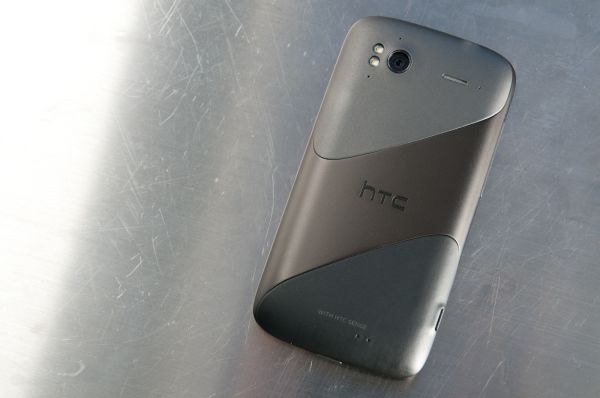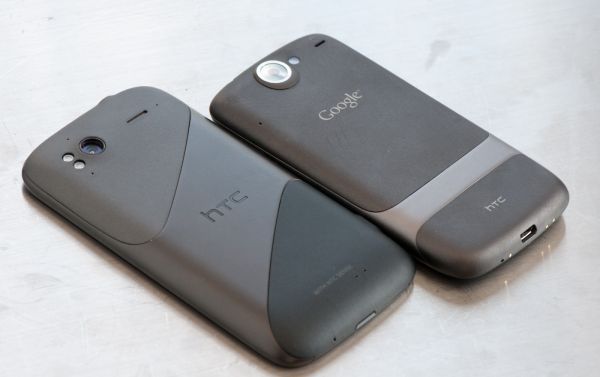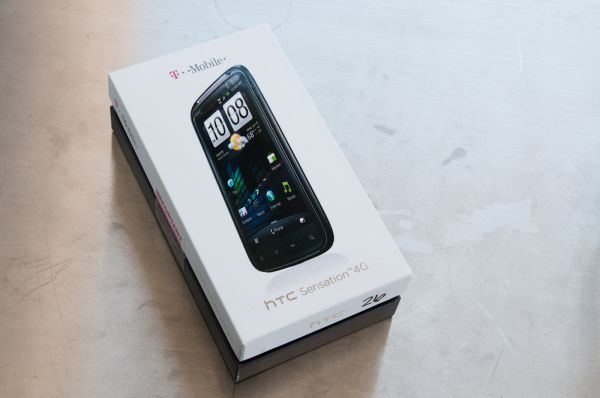HTC Sensation 4G Review - A Sensational Smartphone
by Brian Klug on July 1, 2011 12:38 AM EST- Posted in
- Smartphones
- HTC
- Android
- Mobile
- HTC Sensation
- MSM8260
I like what HTC has been up to lately. Rather than fighting a race to the bottom with endless soulless variants of the same piece of hardware in a crowded (and fiercely competitive) Android handset market, it’s trying to grow beyond just being a handset manufacturer.
I hate starting reviews with history lessons, but in this case we really do need to step back to see where HTC is coming from. In the beginning, HTC was a nameless OEM for other more famous brands. Its clients were smartphone and Pocket PC names like Palm with its Treo, Compaq with its iPaq, Dell with a number of the Axim PDAs, and UTStarcomm. As Windows Mobile aged and showed little signs of improving, HTC took its first step outside the bounds of being just a hardware assembler by taking on an ambitious project to revitalize Windows Mobile with a software skin. The fruits of this effort were TouchFlo, and later TouchFlo 3D UIs - which eventually would become HTC Sense. Somewhere between the release of the HTC Mogul and HTC Touch Pro, HTC realized that its future wasn’t purely in manufacturing devices for other handset vendors, but in leveraging its own brand. The combination of continually improving industrial design, software, and its own direction have turned HTC into the device manufacturer it is today.
Things have come a long, long way since the HTC Dream, and today we’re looking at HTC’s latest and greatest with the HTC Sensation.
I get a bit excited every time I look at the HTC Sensation. It’s a device with perhaps the strongest and most bold design language of any HTC phone to date. You can pretty much chart HTC’s design language by looking at each generation of its international handsets.
The HTC Desire was essentially an international version of the Nexus One, with hardware buttons but the same 65nm single core Snapdragon QSD8250 SoC. The second generation was the HTC Desire HD, which brought a larger 4.3” screen and 45nm Snapdragon MSM8255 SoC. The third step is the HTC Sensation, which ups resolution from WVGA 800x480 to qHD 960x540 and brings a 45nm dual core Snapdragon MSM8260 SoC.
| Physical Comparison | ||||||
| Apple iPhone 4 | HTC Thunderbolt | LG Optimus 2X/G2x | HTC Sensation | |||
| Height | 115.2 mm (4.5") | 122 mm (4.8") | 123.9 mm (4.87") | 126.3 mm (4.97") | ||
| Width | 58.6 mm (2.31") | 67 mm (2.63") | 63.2 mm (2.48") | 65.5 mm (2.58") | ||
| Depth | 9.3 mm ( 0.37") | 13.2 mm (0.52") | 10.9 mm (0.43") | 11.6 mm (0.46") | ||
| Weight | 137 g (4.8 oz) | 183.3 g (6.46 oz) | 139.0 g (4.90 oz) | 148 g (5.22 oz) | ||
| CPU | Apple A4 @ ~800MHz | 1 GHz MSM8655 45nm Snapdragon | 1 GHz Dual Core Cortex-A9 Tegra 2 AP20H | 1.2 GHz Dual Core Snapdragon MSM8260 | ||
| GPU | PowerVR SGX 535 | Adreno 205 | ULP GeForce | Adreno 220 | ||
| RAM | 512MB LPDDR1 (?) | 768 MB LPDDR2 | 512 MB LPDDR2 | 768 MB LPDDR2 | ||
| NAND | 16GB or 32GB integrated | 4 GB NAND with 32 GB microSD Class 4 preinstalled | 8 GB NAND with up to 32 GB microSD | 4 GB NAND with 8 GB microSD Class 4 preinstalled | ||
| Camera | 5MP with LED Flash + Front Facing Camera | 8 MP with autofocus and dual LED flash, 720p30 video recording, 1.3 MP front facing | 8 MP with AF/LED Flash, 1080p24 video recording, 1.3 MP front facing | 8 MP AF/Dual LED flash, VGA front facing | ||
| Screen | 3.5" 640 x 960 LED backlit LCD | 4.3” 800 x 480 LCD-TFT | 4.3" 800 x 480 LCD-TFT | 4.3" 960 x 540 S-LCD | ||
| Battery | Integrated 5.254Whr | Removable 5.18 Whr | Removable 5.6 Whr | Removable 5.62 Whr | ||
Physically it’s obvious that each successive device builds on the former. They’re all backed with HTC’s trademark purple-grey metal and have similar in-hand feel as a result. When I look at the Sensation, I see the Desire crossed with the Desire HD. When I actually hold the Sensation, I feel like I’m holding a grown-up Nexus One.
The two share that trademark combination of slightly rubbery plastic and metal, and as a result the device feels grippy, solid, and confident. What the Sensation also really continues from the other devices is the lack of a hard lip of any kind at the edge, instead every corner rolls off giving the phone a smooth feeling. The sensation of holding something rigid and expensive is communicated by that combination of materials, rather than the cheap plasticky feel conveyed by a number of other handsets.
The Sensation comes in the same style of packaging that we've seen other T-Mobile phones arrive in. It's a two-part box with a thin middle strip. The top lifts off revealing the phone, and underneath that is the usual paperwork, HTC AC adapter and microUSB cable, and earbuds.
I started off making one monolithic video for the Sensation, but that ended up being unwieldy, so I split it into multiple parts. The first one is simply a look at the hardware from all angles, torn down, and how it compares to both HTC's legacy devices and some of its modern contenders.



















107 Comments
View All Comments
Chloiber - Friday, July 1, 2011 - link
It's just a warmer white. On AMOLED displays, the white is very blueish (at least in the tested display in this article. Some like it "colder", some "warmer". And yes: AMOLED still produces way too oversaturated colors. It's like turning contrast way too high on your TV (that's often the setting in the shops). People go "Aaahh, look at those colors!" but in reality it's just horrible.The best way to find out is watching a football game. If the green color of the field burns through your eyes, it's wrong ;)
hechacker1 - Saturday, July 2, 2011 - link
It's only yellow/redish in comparison to a that blueish AMOLED. Given a few minutes with the device (not comparing it side-by-side with another) your eyes will adjust to that white temperature.Technically, the internet color-space is designed to be 6500K. So you should want your screen to match that for color accuracy.
Sunlight is closer to 6500K than 8000K for comparison. Ideally the screen would have the full spectrum of the Sun. In reality we can only get an approximation.
jaydee - Friday, July 1, 2011 - link
Battery life was better web browsing on 4G, than browsing on Wifi? How can that be?!metafor - Friday, July 1, 2011 - link
I thought that curious too. Hopefully it's a software issue that will be fixed in upcoming updates. I'd hate to think that the WiFi radio actually consumes more power than HSPA+.Brian Klug - Friday, July 1, 2011 - link
It's confusing to me as well, and something we're starting to see on a few devices lately. I was very puzzled by the result, ran that test twice and still got the same result.-Brian
Stuka87 - Friday, July 1, 2011 - link
Lucky guy!And great review. HTC has come such a long ways. I definitely consider the Sense UI to be far nicer than that of base Android or other OEM's.
rahvin - Friday, July 1, 2011 - link
I haven't used Sense on Android but I have used it on Windows mobile and liked it. But you should really take a look at some of what Engadget found in regards to what Sense does to battery life. It's quite astounding really, in some phones it caused a 50% drop in battery life.poohbear - Friday, July 1, 2011 - link
When are you guys gonna review the Samsung Galaxy S2?? that's a beast of a phone and the best smartphone on the market today. My Korean friend has it and its insane!!! Cna't wait for it to come to America!yelped - Friday, July 1, 2011 - link
Ok, thanks. Great job on the review!introiboad - Friday, July 1, 2011 - link
I really want to see a review of the Galaxy S 2, given that it uses the Exynos SoC with a brand new GPU from ARM itself. Benchmark results are lacking without it :)